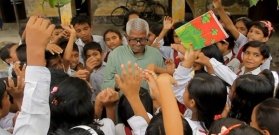
TK Reading Club: Kahon Mahorathuk (The Gigantic Horn)
TK park invited literary buffs to attend an event called “TK Reading Club with Kahon Mahorathuk”. Kahon Mahorathuk (The Gigantic Horn) is a suspense novel penned by Chairat Phiphitphatthanaprap, known by his pseudonym “Prap”, an energetic young writer who won the best novel award from the 2014 Naiin Award. His novel was also shortlisted for the final round of the 2015 South East Asian Writers Awards (S.E.A. Write Award) on the Asian best creative literature. The event was honoured by the presence of MrPrap who was warmly welcomed by his audiences.
Readers’ Feelings towards Kahon Mahorathuk
Besides great pleasure and excitement of the suspense novel, the readers would like to express his feeling towards Kahon Mahorathuk that…
One of the readers said it was a bit of a shame the moment revealing the heart of the story was too concise as a character appears and unveils all hints in the story.
As for young readers, they flavour a twist ending which is unexpected and difficult to predict. Some lovethe book’s settings which arefamiliar historical sites in their daily life such as Wat Pho as they can imagine the scenes during the reading. Also, a narrative approach used in the novel is a western style rather than a Thai one. Setting of Thai crime fictions mostly are in historical period such as Sorajak Siriborirak’s novels.
In the aspect of language used in the novel, Mr Prap also exchanged his idea with his audiences. A group of young readers said his language was difficult for them to understand as it was too obsolete. However, they said this issue was partly because of their ages and reading experience as well.
One reader said Mr Prap was not necessary to worry about his language in his work because young readers will understand his message when they grow up.
Poem and Plot: Before Becoming Kahon Mahorathuk
Mr Prap said he wrote Kahon Mahorathuk mainly based on Thai concrete poetry as it was easy to understand rather than other types of Thai poems. The poem itself was suitable to be applied to characters in his novel including Wat, Cheep, Sak, Am and Lu. He adopted the poetry idea from ancient Thai concrete poems adorned in Wat Pho. Also, he was afraid he would explained some details incorrectly if he chose other poems with complicated principles such as the Roop PhayaNak (a naga picture) poem, or called Patipat Phuchong.
Mr Prap then used the poem to tell stories of the five victims. Each poem was a short story of each person. In the first place, he thought about creating a connection among the five. However, he later decided it was not necessary as it could be five separate short stories of each character who experiences different situations.
Mr Prap said he would record his storyline and other details including date, time and event in Microsoft Office Excel. The story would be narrated based on chronology so that it would be easier for readers to understand. Dates would always come along with events occurring in the book. Aside from creating better understanding among readers, the chronology was relevant to the disclosure of the heart of the story at the end as well.
History in the Novel
Asked why his novel was based on historical events although Mr Prap earlier said he did not have a particular interest in history, he explained his work was inspired by both history and art of writing fiction.
He also exemplified historical events in his novel which were the oil leak a few years ago and the government’s espionage mission assigned to Sunthorn Phu, a Thai renowned poet in the early Rattanakosin era, which remained a secret until today. Both events were linked in his book as he used them as materials.
In addition, despite being categorised as a novel, Kahon Mahorathuk does not neglect history as the plot was based on true events including the country’s changing political situation during the administration of Field Marshal Plaek Phibunsongkhram, the Boworadet Rebellion, World War II, a prison on Koh Tarutao and the background of Wat Pho.
As for Wat Pho, Mr Prap said the temple was interesting. Even though Thais have been familiar with the place, several other details of the temple remained to be explored. After the country’s administration was changed in 1932, Field Marshal Plaek wanted to develop Thailand into a civilised country in a bid to escape colonialism. Therefore, he devised a state convention policy. Under the policy, Thais at the time were required to wear hat and not allowed to eat betel nut while the country’s name was as well changed from Siam to Thailand.
For incorrect use of orthography in Thai language (deletion of some Thai consonants which have similar sound such as ษ with the replacement of ส instead for easier writing) which came along with “Sawasdee”, a Thai greeting word meaning Hello, Mr Prap said during Field Marshal Plaek’s administration, there was a rumour a Japanese force questioned whether Thai authorities played a trick on them by writing style in letters. Therefore, the force proposed Thais to make some changes to the writing style so it would be easier for them to understand.
Mr Prap also mentioned Sri Burapha, a renowned writer and journalist who was greatly admired by a heroine in his novel, saying he decided to put the character in his story as Sri lived during the period of the settingin the book. Also, the heroine works as a journalist for a newspaper affected by political situation at the time. Besides, Mr Prap decided to select the renowned journalist in order to attract readers as there were a few well-known journalistsduring that period.
Mr Prap added he first intended to write more about the Boworadet Rebellion as he had a specific interest in the rebellion event. However, he was unable to create much connection between the rebellion and his plot so the event appeared in the book less than he expected.
One of the readers also voiced his opinion on the setting in the novel, saying he would feel a little bored if historical events in the book were not issues he was interested in.
One young reader also felt the book was difficult to read while another book fan loved the novel as historical backgroundhelpedbroadenhis horizons. Readers sometime though they knew some issues well despite the fact that there were many other details left to be discovered. Also, historical events in the book were not generalinformation so they did not make readers feel bored. Besides, readers did not feel they were forced to receive unwanted content.
A Complex of Characters: Mental Disorder or Psychological Complex
Cold-blooded and collected vengeance of a villain made several readers questionwhether the character suffers mental illness.
Mr Prap revealed the villain has a complex and deep scar on his mind which drive him to commit the retaliation. He is not a psychopathic killer. Even Kla, henchman of the killer, he does not suffer mental disorder. He is just a subordinate who is loyal to his master. Therefore, all his actions intend to please his master.
Come to this point, readers also questioned why Kla, who is illiterate, is capable to leave poems in crime scenes after the murders.
Mr Prap said his editor also objected to this issue. Nevertheless, he insisted despite illiteracy, Kla can still write those poems as he feels attached to his master. The poetry is the only thing connecting him with his boss. Besides, Kla is different from ordinary people as he views everything as poetry while normal people will imagine pictures in their heads because Kla’s mind is bound to his boss.
Also, Waithip, a character who is a daughter of Panonit, readers believed the girl who enjoys assaulting an old man could suffer mental illness. On the other hand, her act could only mirror her innocence like other normal children.
One reader said the ending was also a pivotal part which made this novel different from other Thai novels. A concept “I don’t care what readers think about my ending” made readers more feel like they were reading foreign novels.
The concept accomplished in taking the audience to the extreme pleasure and excitement of the reading, the reader added.
Mr Prap said he first worried about the ending as he wrote Kahon Mahorathuk for a book award competition. Also, he did not read any award-winning books while working on it. He thought most books in the contest centred on “virtue” in society. Therefore, he was not certain whether the ending of his book was too harsh for the judge panel. Nevertheless, Mr Prap said he decided to stick with his ending because he believed he would regret it if he did not end the story the way he had intended to. However, it turned out that the judge panel liked his book and it surprised him.

The origin of the nickname “The Dan Brown of Siam”
Due to Prap’s exciting investigative stories, which depict the functioning of a probe, the author was nicknamed “the Dan Brown of Siam” by his readers.
Mr Prap revealed that, the first time he saw this sentence on the cover of one of his books, he felt a great deal of pressure, in part because he has not read many of Dan Brown’s novels.
However, he admitted that the American author is among his influences. If he had not read “The Da Vinci Code”, perhaps he wouldn’t have written Kahon Mahorathuk. Therefore, it is a great honour to be nicknamed after Dan Brown.
Today, Mr Prap feels that the pressure is less intense, as he understood that the nickname was chiefly a marketing ploy.
One reader shared his opinion, saying that the narration, language, dialogues and themes in Mr Prap’s book were very modern – unlike in a period drama. It is similar to Dan Brown’s novels, mixed with CSI-type investigation stories.
Another reader added that he found few other Thai investigative novels like this one. Mr Sorajak, for example, does not narrate the details of the investigation the way Mr Prap does, he argued.
Short List S.E.A. Write 2015
Mr Prap recalled his feelings when he learned of his nomination for the S.E.A. Write Award and said he was happy but didn’t believe he could win. He wrote his novel as pure entertainment, but the S.E.A. Write Award is beyond that.
Two of his novels appeared on the Long List: Kahon Mahorathuk and Niras Mahannop (Journey to the Ocean).
Mr Prap hoped for Niras Mahannop to be shortlisted, rather than Kahon Mahorathuk. However, it was the opposite that happened.
The novel's distinctive narrative feature - its use of gon klong, a form of rhyme scheme in Thai poetry - as well as its uncommon topic - few Thai novels deal with crime stories the way Kahon Mahorathuk does, depicting the investigative process - are among reasons why it was shortlisted.
Kahon Mahorathuk is also a period novel and includes works by poets as well.
East meets West: Kinda Iji VS. Robert Langdon
Although Mr Prap was partly inspired by Dan Brown's novels - which portray a hero named Robert Langdon - the Thai novelist reveals that, as he was writing his book, he didn't think about Dan Brown, but admired Kinda Iji's works instead.
As he began working on his novel, Mr Prap asked himself why he liked Kinda Iji's writing. He made a list with the different reasons and one can see, reading Kahon Mahorathuk influences from Kinda Iji.
For instance, the novel's chapters are very short and the crime takes place in a closed room.
One reader said he felt a little disappointed, when the crime was solved, to learn that the five victims were in fact unrelated.
However, Mr Prap argued that, not only did he want the victims' names to be tied to the "gon klong" rhyme, but he also wished to convey the feeling that the story's heroine is vengeful, sometimes beyond reason. Therefore, not all victims needed to be related, he said.
Writing for fun VS. writing for a competition
Mr Prap revealed that the two forms of writing differ vividly from the start. A competition usually sets a theme or a goal, such as to sustain society.
Mr Prap wrote Niras Mahannop for fun, therefore he could write it the way he wished.
Nevertheless, writing for a competition has its benefits too.
It provides a frame, therefore one cannot drift too far, and a deadline, meaning one has to work seriously and complete their goal.
The downside with writing competitions in Thailand is that they are often organised in support for some "valuable cultural traditions" but many people may have different conceptions of these. At the end of the day, no one can judge which cultural aspects are more important than others. But it's up to each person or writer to decide how much they are willing to risk.
His favourite writers
Mr Prap said he admired Thai writers Thomayanti and Sorajak, as well as American novelist Sidney Sheldon. Today, he reads all kinds of novels from various authors. However, the book that changed his life was "The Kite Runner" by Khaled Hosseini.
How to write stories in Prap's style
Towards the end of the session, many young readers manifested their interest in writing novels. Therefore, they asked Mr Prap for advice and tips on how to become a writer. They had a fun and lively discussion as a result.
Mr Prap revealed that he wanted to become a writer since he was a child. Whenever someone asked him what he wished to do in the future, he replied that he would be a writer. However, many people disapproved of it.
One adult reader argued that many adults or parents believe that writing is not a profitable career, and are therefore worried about their children wanting to become novelists.
Nonetheless, Mr Prap accomplished his childhood dream. Furthermore, his work is recognised for being thrilling as well as easy to understand.
Mr Prap, who studied commerce and accounting rather than literature, said he wished to write novels accessible to the larger public. His writing career stemmed from the fact that he liked reading thrillers, crime and investigation novels, as well as gon klong.
He told the younger audience to keep reading many books and write whenever and whatever they feel like writing, starting right away. Aspiring writers can take writing classes if they have the opportunity to do so, he added, as valuable tips can be learned there. Furthermore, a lot of research must be done prior to writing a novel, so that it will contain valuable information.
Finally, Mr Prap revealed that he jotted down information regarding every place he visited. When he could not see the places for himself, he looked for information elsewhere and had experts read parts of his chapters as he wrote them, asking for their comments.
We will meet again for further fun activities, because reading is not only schoolwork.
Chestina Inkgirl.







